
Image Credit: Pixabay
Are sloths really lazy? Scientists and animal fans have discussed this for years. When we think of sloths, we usually see them chillin’ in trees, not doing much. But is this true? This article will explore the world of sloths to find out.
Sloths are known for their slow movements and low-energy lifestyle. They like to hang upside down, blending in with the trees. This made people think sloths were lazy. But there’s more to it than that.
Sloths’ slow movements aren’t lazy, they’re their way of life. They have an extra slow metabolism, so they don’t need much energy. This helps them survive in the wild, where food can be hard to find.
Plus, their diet makes them seem lazy. Sloths only eat leaves, which aren’t very nutritious and take a long time to digest. So they need to take their time to get energy from their food.
Sloths aren’t lazy, they’re smart! Their energy-saving ways help them survive in the wild. So next time you see a sloth lounging around, remember their awesome adaptations and how they help the environment. Appreciate these fascinating creatures!
Key Takeaways
- Sloths are often perceived as lazy due to their slow movements and low activity levels, but this is a misconception.
- Sloths have evolved to have a slow metabolism and low energy requirements, which allows them to conserve energy and survive on a diet of leaves.
- The slow movements of sloths are actually an adaptation to their arboreal lifestyle, helping them blend in with their surroundings and avoid predators.
- Sloths may appear lazy, but they are highly efficient in their energy usage and can move quickly when necessary, such as when escaping danger.
- Sloths spend most of their time sleeping and resting, but they are still able to fulfill their basic needs and survive in their natural habitat.
- The perception of sloths as lazy animals is largely influenced by human standards of productivity and activity, which may not be applicable to their unique biology and lifestyle.
- Understanding the true nature of sloths can help us appreciate and protect these fascinating creatures, rather than labeling them as lazy.
Description of sloths and their behavior

Sloths are famed for their sluggish tempos and seemingly indolent behavior, yet they remain captivating creatures with remarkable features. They like to hang upside down from the trees of Central & South America’s rainforests. This uncommon stance helps them save energy as they have a sluggish metabolic rate.
Leaves are their primary source of food. This nutrient-poor diet has caused sloths to adapt by having a slow digestion process, which can take up to a month to complete. This permits them to survive on meager food resources.
An intriguing symbiotic relationship exists between sloths and algae & fungi, which grow on their fur due to their sedentary lifestyle. The greenish hue of their fur provides camouflage & helps them blend into the trees.
Despite their sluggishness, sloths are great swimmers. They use their long arms to paddle through the water easily. This skill assists them when they need to move between trees or reach new feeding grounds during floods.
Pro Tip: Sloths may appear lazy, but they have various strategies that let them succeed in their habitat. Watching these unique creatures can grant valuable insights into the diversity of nature.
Exploring the misconception of sloths being lazy

Sloths are often seen as lazy, but this is an unfair judgement. Let’s take a look at what makes these creatures unique.
It’s not that sloths are lazy, it’s that they have a low metabolic rate. So their slow movements are actually an energy-saving adaptation. Plus, hanging in trees all day requires very little effort.
Human influence has made life harder for sloths. Deforestation and habitat loss have decreased their food sources, which can make them seem lazy as they save energy and rest.
To help sloths, we can:
- Create protected areas
- Educate the public about their unique adaptations
- Support conservation efforts such as reforestation and habitat restoration
Sloths’ energy conservation strategies are amazing – the laziest of us have nothing on them!
Evidence of sloths’ energy conservation and survival strategies
Sloths have been seen as lazy creatures due to their slow movements. But this is actually an adaptation strategy for conserving energy and survival.
They have unique traits and behaviors that help them thrive in their environment. For instance, they have a low metabolic rate which lets them survive on a low-nutrient diet of leaves.
Plus, they can hang upside down from branches for hours with minimal energy. This helps them to hide from predators.
It is important to learn from the sloth’s energy-saving methods. In a world where resources are getting scarce, it’s wise to use energy wisely.
Let’s take a cue from the sloth and conserve energy by avoiding activities that don’t matter. That way, we can make a better future for ourselves and the planet. Don’t miss out on the wisdom of these resourceful and seemingly lazy creatures!
Examining the importance of energy conservation in sloths’ natural habitat
Sloths conserve energy in their natural habitats in unique ways. They have slow metabolisms and move leisurely, avoiding predators like hawks and jaguars. This slow pace also helps them navigate the trees and avoid injuries.
Sloths eat leaves, which are low in nutrition, so they spend a long time digesting to get the most out of the food. They also minimize movement and sleep a lot, meaning they need less calories than other animals.
These adaptations show us how important energy conservation is for sloths – and how important it is to preserve their environments. We need to act now, before we miss out on seeing these amazing creatures. Together, we can make a difference!
Comparing sloths’ behavior to other animals

Comparing sloths to other animals reveals fascinating differences. Let’s take a look at a table that captures their distinct traits:
| Criteria | Sloths Compared | Other Animals |
|---|---|---|
| Speed | Slow | Fast |
| Activity | Leisurely | Active |
| Diet | Plants | Plants or small animals |
Unique aspects worth noting are the specialized adaptations of sloths that allow them to survive. Their slow metabolism helps them conserve energy and spend time upside down in trees.
Algae grows on their fur due to their deliberate slow movements and limited grooming habits. This creates camouflage and provides extra nutrition.
Sloths spend up to 90% of their lives in trees. National Geographic says they rarely leave the branches except for bathroom breaks or when searching for a new tree.
Move over, couch potatoes! Sloths are here to show you how it’s done!
Addressing the cultural perception of laziness and its impact on the sloth’s reputation
Sloths are often seen as lazy, but this is a misunderstanding of their evolutionary adaptation. They have low metabolic rates and hang upside down in trees to conserve energy. Even though they are slow, they possess strong muscles for climbing and moving.
Sloths also play an important role in ecosystems. They disperse seeds by eating fruits and excreting them in different locations. This contributes to biodiversity and forest regeneration.
We must move away from the idea that sloths must be productive like humans. Instead, we should admire their unique adaptations that have allowed them to survive for millions of years. Appreciating these creatures can foster a deeper empathy towards all life on our planet. Let’s celebrate the incredible richness and diversity of our world before it’s gone. Sloths may be slow and lazy, but hey, at least they’re living the dream while the rest of us are stuck in rush hour traffic.
Frequently Asked Questions
1. Are sloths actually lazy?
Despite appearances, sloths are not lazy. They have a slow metabolism and move slowly to conserve energy. Their slow movements help them survive in their natural habitat.
2. Do sloths sleep all the time?
Sloths sleep for around 15 to 20 hours a day. However, this doesn’t mean they are lazy. They have adapted to a sedentary lifestyle to minimize energy expenditure.
3. Why do sloths move so slowly?
Sloths move slowly due to their low-energy diet of leaves. Their slow metabolism helps them digest these leaves efficiently. Moving slowly also helps them stay hidden from predators.
4. Are sloths active at night?
Sloths are mainly nocturnal, which means they are most active during the night. Being active at night allows them to avoid daylight predators and conserve energy during the day.
5. Can sloths move quickly if needed?
Sloths are capable of moving faster when necessary, although they are not built for speed. They can crawl at speeds of about 0.15 mph (0.24 km/h) when they need to escape danger or find a new tree for food.
6. Do sloths have any advantages to their slow lifestyle?
Yes, sloths’ slow lifestyle offers advantages. Moving slowly allows them to blend in with their surroundings, making it harder for predators to spot them. It also helps them conserve energy and maintain a low-impact diet.
Conclusion
Sloths are not lazy creatures! Though their slow pace and chilled-out attitude may look like laziness, this strategic movement helps them avoid predators and get food. They have special adaptations, like their low metabolism and long claws, that help them survive. Plus, they play an important role in rainforest ecosystems by spreading seeds through their poop!
Back in the 18th century, early explorers found these creatures and thought they were super lazy. But as research grew, it became clear they had adapted to their environment. Through biomechanics and physiological adaptations, sloths have made a successful place for themselves in the rainforest.
So, let’s appreciate the complexity and diversity of our world and bust the myth that sloths are lazy.
References
The power of sloth: six reasons why this lazy animal is perfectly evolved

